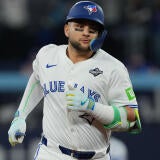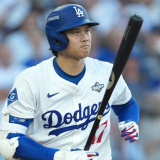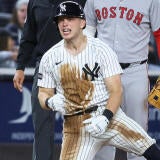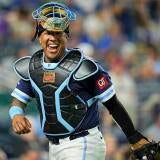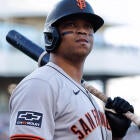Fantasy Baseball: With home runs up, five pitchers who can still thrive
The pitching environment these days is tough to navigate, with the ball flying out of the park at record rates. Here are some pitchers who can provide value in spite of that
Aaron Sauceda is a strategic consultant who puts his skills in financial modeling to use in analyzing Fantasy sports. He has developed his own all-new stat to analyze the quality of a pitcher's stuff — ACES — and you can see the results of that only on SportsLine. Here is his latest analysis on the changing pitching environment around MLB, and who might be able to thrive in it:
Maybe I write too much about pitching. This offseason we debuted the ACES metric — more on this coming soon — and a handful of pitching sleepers to target late in your drafts based on their ACES results. Just a couple weeks ago we discussed five pitchers making changes to their repertoire that could propel them to a new level of play.
I badly want to talk about something other than pitching but I can't. Maybe it's the nightly reminder of my pitching staffs getting bludgeoned to death. Starting pitchers are giving up more home runs than, like, ever. Literally. Since baseball was invented, we've never seen more home runs per nine innings (HR/9) than starting pitchers are allowing so far this season.
And it's still just April! The weather hasn't even fully warmed up yet! Eno Sarris suggested that this is perhaps the result of a combination of two forces ($) — a different ball and hitters continuing to get smarter with their approach.
If nothing else, I think it's becoming safe to say that there's something … different:
2017 & 2019 BBEs for Mar-Apr
— crosby spencer (@crosbyspencer1) April 24, 2019
2017
Bar/BBE%: 6.64
HR/Bar%: 55.98
2019
Bar/BBE%: 8.14 (+22.64%)
HR/Bar%: 55.62
The ball is performing like 2017 barrels, but, is being barreled more often. Info 👇makes me believe it’s ball & approach
2018
Bar/BBE%: 7.69
HR/Bar%: 47.00
How should we react to this environment, if at all? These are the types of questions that keep me up at night and I posed a variation of this last week:
If we were drafting again today, how would the changes we've seen so far -- diff ball (?), more strikeouts/walks/homers, higher ERA/FIP, etc. -- have changed your STARTING PITCHING strategy, if at all?
— Aaron Sauceda (@RotoPope) April 24, 2019
I would have ...
I could have worded the question better to define "changing strategy" as shifting away from the typical 67/33 hitter/pitcher split often cited during draft season, but still, I was surprised at the results. I was particularly surprised that nearly two times more people would have invested less in starting pitching than investing more. I don't totally blame them — aces haven't aced yet, after all.
I'd lean the other way and invest more — particularly with this, um, different ball and others nearly two times more inclined to invest less. This environment is also making power more ubiquitous — even if, yes, I know you need more of it to compete — creating an opportunity to differentiate through pitching.
I think that is why I keep writing about pitching — something is different and we need to figure out the best way to respond. Perhaps we start with, "what type of pitchers should we be targeting?"
A good strikeout minus walk (K-BB%) ratio will never go out of style. It's still our best in-season predictor of future performance. If we have our K-BB% entrée, what about the sides? A good side dish really helps a meal punch above its weight.
Given that home runs are being given up in record numbers, fly balls are scarier than ever — in fact, they're currently yielding the highest isolated power (ISO) on record.
Consider the damage a flyball has been doing compared to a grounder this season:
BB Type | Count | % | AVG | SLG | ISO | wOBA | wRC+ |
Fly Balls | 8,249 | 36% | 0.243 | 0.745 | 0.502 | 0.388 | 145 |
Grounders | 9,660 | 43% | 0.233 | 0.255 | 0.022 | 0.212 | 27 |
(NOTE: doesn't add to 100% as line drives aren't shown)
Fly balls doing more damage has long been the case but has been exacerbated over the last 15-plus seasons.
As you might expect, fly ball pitchers — those in the highest quartile of fly balls allowed (FB%), or those allowing more than 40% FB% — are prone to more homers and higher ERA's:
Season / Type | Count | HR/9 | ERA | GB% | FB% | K-BB% |
2017 | | | | | | |
Fly Ball SP | 33 | 1.46 | 4.41 | 37% | 43% | 13.6% |
All Other SP | 92 | 1.20 | 4.19 | 47% | 32% | 13.3% |
2018 | | |
| | | |
Fly Ball SP | 27 | 1.38 | 4.18 | 35% | 44% | 14.5% |
All Other SP | 101 | 1.11 | 3.98 | 45% | 33% | 14.8% |
2019 | | |
| | | |
Fly Ball SP | 22 | 1.45 | 4.36 | 38% | 44% | 16.0% |
All Other SP | 60 | 1.15 | 4.11 | 46% | 33% | 14.7% |
This is despite similar or better skills in many cases! (As judged by K-BB%). Not only that, the gap between the two is widening. Fly ball pitchers are allowing relatively more homers and relatively higher ERA's when compared to non-fly-ball pitchers ("All Other SP") than they have during the last two seasons.
Luckily for us, fly balls and grounders "stabilize" more quickly relative to other balls in play, according to FanGraphs. We're reaching the point for starting pitchers where we can start to put more weight into those figures:
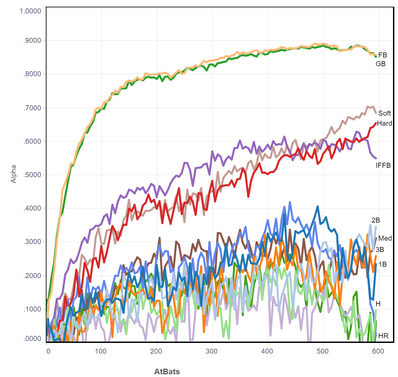
And unlike line drives, fly balls and grounders are among the stickiest pitching statistics we have, implying there's a strong element of skill in generating them.
I think that helps solidify our rubric. Let's start with starting pitchers who have pitched at least 30 innings (roughly 5-7 starts) — that leaves us with 82 starting pitchers — and shorten our list to those who meet the following criteria:
- Keep the ball out of play (strikeouts) and don't give free bases (walks) — above 50th percentile by K-BB%
- Keep the ball out of the air (fly balls) — above 50th percentile by FB%, where a lower FB% is better
- Relevant projected rest-of-season (ROS) performance — ROS projected ERA better than current league median (4.24 ERA) (projected ERA's are the average of Steamer and THE BAT)
I included the last point because research by Mitchel Lichtman has found that ROS projections are almost always more predictive than year-to-date (YTD) performance — no matter where we are in the season — for both hitters and pitchers.
Applying those filters leaves us with 16 names left on our list, sorted here by K-BB%:
Name | IP | K-BB% | FB% | Proj ERA | '18 ACES | ERA | SIERA | FIP | xFIP |
Max Scherzer | 39 | 30.8% | 32% | 3.15 | 80% | 4.12 | 2.56 | 2.22 | 2.37 |
Stephen Strasburg | 37 | 25.2% | 33% | 3.66 | 94% | 3.82 | 3.07 | 3.43 | 2.85 |
Jack Flaherty | 31 | 23.1% | 35% | 3.68 | 58% | 4.06 | 3.38 | 4.40 | 3.22 |
Tyler Glasnow | 36 | 22.6% | 33% | 3.70 | 67% | 1.75 | 3.32 | 2.67 | 3.14 |
Luke Weaver | 31 | 21.6% | 33% | 4.14 | 81% | 3.73 | 3.46 | 3.33 | 3.41 |
Brandon Woodruff | 31 | 20.1% | 34% | 4.23 | 86% | 5.17 | 3.69 | 3.59 | 3.66 |
Noah Syndergaard | 34 | 19.6% | 33% | 3.47 | 100% | 6.35 | 3.63 | 3.70 | 3.55 |
Luis Castillo | 43 | 19.4% | 27% | 4.02 | 96% | 1.45 | 3.65 | 2.79 | 3.31 |
Pablo Lopez | 32 | 18.5% | 31% | 3.80 | 69% | 4.78 | 3.72 | 2.99 | 3.81 |
German Marquez | 46 | 18.0% | 27% | 4.20 | 62% | 2.93 | 3.64 | 3.44 | 3.37 |
Joey Lucchesi | 31 | 17.4% | 28% | 4.08 | 5% | 4.94 | 3.83 | 3.56 | 3.45 |
Trevor Bauer | 47 | 16.9% | 32% | 3.55 | 88% | 2.45 | 4.11 | 3.53 | 3.77 |
Eduardo Rodriguez | 30 | 16.6% | 33% | 3.99 | 86% | 6.16 | 4.06 | 3.80 | 3.93 |
Cole Hamels | 36 | 16.5% | 26% | 4.20 | 43% | 3.19 | 3.76 | 3.57 | 3.48 |
Ross Stripling | 34 | 16.2% | 28% | 3.86 | 66% | 2.65 | 3.90 | 3.73 | 3.63 |
Marcus Stroman | 37 | 14.6% | 28% | 3.92 | 63% | 1.43 | 4.08 | 2.31 | 3.70 |
That's a fun list — a lot of potent, raw stuff! Right away we can start crossing some names off — you don't need me to tell you that Max Scherzer, Stephen Strasburg, Noah Syndergaard and Trevor Bauer are good. Although maybe this is a nice reminder? (Strasburg, with his decreased fastball velocity by roughly 2 mph, should be approached with caution, however).
Good luck trading for Tyler Glasnow or Luis Castillo right now. Similar story for Jack Flaherty or German Marquez. If you can acquire any of those names at any discount, I'd be a happy buyer. Poke around your leagues to be sure owners know what they have.
If you currently have any of those guys on your team, enjoy. However, make sure you pay attention to these other names on this list — the "have nots," if you will.
LUKE WEAVER
Weaver spent his offseason analyzing his repertoire with a Rapsodo machine and the early returns have been promising. Lance Brozdowski recently interviewed him for Baseball Prospectus, discussing his increased cutter usage, increased whiffs on the changeup and increased drop and whiffs on the curveball. The total package has benefited nicely — seeing improved strikeouts, walks and swinging strikes. He has the stuff (77th percentile by ACES in 2017, 81st percentile in 2018) and he's already had some success at the major league level. Projections aren't loving him — yet — but Weaver possesses a skilled profile.
BRANDON WOODRUFF
Wait! Don't leave! Only one pitcher has allowed more line drives so far this season than Woodruff, which might help explain how he's gotten hit so hard. Still, line drives are the least predictive batted ball type. The next piece of compelling research I see that suggests giving up line drives is a sticky "skill" will be the first. If those line drives start turning into fly balls, perhaps the home runs continue … which is a problem in that park. But he generated grounders at an above-average rate the last two seasons (53% in 2018, 47% in 2017) — albeit primarily as a reliever — so there's precedent to suggest he possesses skills to avoid fly balls. Command doesn't appear to be a problem — he was at least league-average by Command+ in 2017 and 2018 — and you don't find an 81st percentile K-BB% on your wire very often. I'm holding or adding and keeping a close eye on the trend of his line drives allowed.
PABLO LOPEZ
Ahh, one of the stallions. The results haven't been there so far (4.78 ERA) but the projections are optimistic going forward (3.80 projected ERA ROS) and he's one of three pitchers on this list who are least 74th percentile by both K-BB% and FB% allowed (the other two are Max Scherzer and Luis Castillo). His repertoire is largely unchanged from last season, when he flashed 69th percentile stuff by ACES. His sinker and changeup remain elite at generating grounders — a perfect recipe for suppressing home runs, particularly in that park — while he's getting above-average whiffs on his fourseam, changeup and curve. Caleb "K-aleb" Smith is deservedly receiving much of the attention in Miami, but don't sleep on this other stallion.
EDUARDO RODRIGUEZ
This is perhaps the toughest call of all. Rodriguez has been among the most frustrating pitchers to watch so far this season. He has everything you want — plus stuff, above-average command, a deep and balance arsenal, and he's even healthy right now! While the results haven't been great so far (6.16 ERA, 1.53 WHIP), he's been better than 60th percentile by both K-BB% and FB% allowed and projections still see a sub-4.00 ERA. His pitch mix hasn't appreciably changed since last year, when he posted a 3.82/3.65/3.90 ERA/FIP/xFIP. Whiffs on the slider are down but that was never a plus or featured pitch for him; otherwise, whiffs are up across his other pitches. He's generating more grounders and fewer fly balls. As much as it pains me to say, I can't quit this profile. Maybe that's what makes a true "buy low" — when you feel sick to your stomach just thinking about it.
COLE HAMELS
As Scott Pianowski has been pimping all offseason, Hamels is the boring veteran you unconsciously cross off from your draft list … but shouldn't. The stuff is no longer elite (64th percentile by ACES in 2017, 43rd percentile in 2018) but in 113 innings since joining the Cubs, Hamels has generated a 24.3% strikeout rate, 7.7% walk rate and is doing an elite job of minimizing fly balls — good for a 3.47/3.55 FIP/xFIP and 1.10 WHIP during that time. It'll get tougher when the wind picks up and weather warms, but Hamels is enjoying a legitimate return to relevance … and is worth inquiring about in case someone is looking to "sell high."
QUICK HITS:
- Joey Lucchesi: Lucchesi's two-pitch profile isn't ideal but he's largely the same guy as he was last season — with an identical 3.45 xFIP — when he produced a 4.08 ERA and 24.8% strikeout rate. His arsenal is roughly the same while he's generating more grounders and fewer fly balls. Command alluded him last season but his FanGraphs prospect reports gave him an above-average future grade in Command, suggesting potential to improve. If you liked Lucchesi going into this season, nothing should have changed your mind so far.
- Ross Stripling: Things happen. The Dodgers are among the most liberal teams in using their Injured List (IL), particularly for pitchers. I don't blame you if you don't want to stash — he hasn't been able to maintain the velocity uptick he saw out of the bullpen last season — but he'll likely be back in the rotation at some point and still has that nice curveball. If you don't hold, be ready to grab the second something feels off in the Dodger rotation.
- Marcus Stroman: I briefly touched on this at RotoBaller last week — at the expense of his sinker and curve, Stroman is featuring his slider nearly 40% of the time, helping improve his strikeout rate to 23% while still generating above-average grounders (55%).
It's felt like a tough season for pitching so far. However, it's not time to run away. Differentiate by doubling down on pitchers who keep the ball out of play and out of the air. That's the best way to respond to this environment — and sleep at night.
